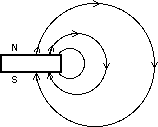It’s still going
It’s still going
Introduction
One end of a magnet can be suspended in the air by repulsion from another magnet. push the suspended magnet gently down and it will oscillate for a long time. Suspend several magnets and they will interact magnetically.
Materials
To Do and Notice
Make a stack of two magnets. (Starting with the stack assures that all of the poles will be properly aligned.)
Hold the bottom one in place by hand, or tape it down, and pull the top one to the side.

Notice that the edge of the top magnet nearest the bottom one rises into the air. With a little practice you can balance one magnet on the edge far from the bottom magnet with its near edge suspended in the air. This is more difficult on a smooth surface. A sheet of paper provides just about the right roughness.
Tap the upper edge of the suspended magnet and watch it vibrate for a long time.
Make a stack of three magnets. Pull the top one to one side and the bottom one to the other. Try to balance them so that they are the same distance from the central magnet.

Tap one magnet and it will start oscillating. However, soon the other magnet will start oscillating. If they are tuned just right, the first magnet will completely stop its motion while the second one oscillates. The second magnet will then pass the motion back to the first one.
To tune the frequency of oscillation of the magnets,move them toward or away from the central magnet.
What’s Going On?
It is interesting to notice that if the north pole of the bottom magnet is up, then the south pole of the magnet stacked above it will be down. The stack holds together because unlike poles attract. And yet, when you pull the top magnet to the side its bottom south face is repelled into the air above the north face of the fixed magnet.
The best way to understand this is to trace the "field lines" from the fixed magnet. The field lines come up out of the north pole face of the fixed magnet then spread to the side reverse direction and go into the south face of the magnet.

The south pole which is pulled down when it is over the north face of the magnet is pushed up when it is placed to the side, because the magnetic field of the magnet loops around and reverses direction from up to down around the sides of the fixed magnet.
The two oscillating magnets can be adjusted to have nearly the same frequency of oscillation. When one starts moving its changing magnetic field pushes and pulls on the other one. The two magnets are tuned to the same frequency so the pushes and pulls come at just the right time to start the second magnet into resonant oscillations. As the second magnet moves it pushes and pulls on the first one at just the right times to bring it to a stop.
Going Further
Try balancing more than two magnets around the central one.
Use two magnets in the center and pull other magnets to the side, what happens to the frequency of oscillation.
So What?
The concept of a field was one of the most important developments in physics. Faraday conceived of the idea that one magnet created a magnetic field throughout space that exerted forces on other magnets and also on moving electric charges. This replaced the older newtonian idea of action at a distance. The idea of fields allowed explorations like this one to be understood. After Faraday, Maxwell wrote his famous partial differential equations describing electric and magnetic fields.
Etc.
Bring a sheet of aluminum .25 cm (1/8 inch) or thicker, such as a cookie sheet or cake pan, near the oscillating magnet and it will rapidly stop oscillating. The eddy currents induced in the aluminum by the moving magnet exert magnetic forces on the moving magnet which stop it.
|
|
8 January 2008 |